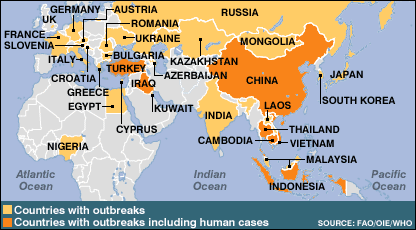HEWITT.MOBI
Monday, February 20, 2006
 The Bird Flu Demographic (BBC)
The Bird Flu Demographic (BBC)An update on my tracking of the spread of Bird Flu.
The Times
February 21, 2006
Problem is not the poultry, it's the people
Analysis by Nigel Hawkes

IS the Government doing enough to prevent the arrival of avian flu? Some think not.
But realistically there is not a great deal more it could be doing. It seems likely — some would say certain — that infected birds will wing their way to Britain. They may well be here already.
What matters is not that wild birds are carrying flu, because they always do. The key is preventing that infection from reaching domestic flocks, or limiting its spread if it does. Suppose the worst: avian flu arrives and some free-range poultry catch it. Then slaughter and isolation should contain the disease. Italy has had six outbreaks of avian flu caused by H5 or H7since 1997 and has controlled them all, though at considerable cost.
What else can be done? Vaccination is a possibility, but the evidence is equivocal. Flu spreads fast and it takes two to four weeks for the vaccine to become effective. Preventive vaccination in advance might help, but Dutch experience shows that at least three-quarters of farms would need to be vaccinated.
The ultimate threat, of course, is not to poultry but to humans. The more H5N1 flu there is among birds, the greater the risk of the jump to a pandemic strain transmissible in humans. The Government has contingency plans to deal with that, but it may be open to greater criticism. The hole in every nation’s armoury is the lack of a vaccine that can be quickly and easily produced.
The Government has placed “sleeping contracts” with manufacturers that ensure, it says, that it will be at the head of the queue for an H5N1 vaccine. It has also asked manufacturers to tender for an order for two million doses, but contracts have not yet been signed, more than seven months after Petricia Hewitt, the Health Secretary, announced the plan.
There must be some concern about just how firm these arrangements are. If a pandemic does emerge, there could be a nasty rush with too little vaccine to go around. Traditional vaccines are not up to ther job — they take too long to make and could not be produced in sufficient volume fast enough.
The issue is whether alternative types of vaccine could fill the gap. Despite repeated prompting by Professor Peter Dunnill of the Advanced Centre for Biochemical Engineering at University College London, there seems little appetite from the Government for investigating DNA-based vaccines — the only type, he believes, that might be produced on time and in sufficient quantity to do any good.
Charlie
hewitt.mobi Posted at 11:27 pm |
0 comments
0 Comments:





